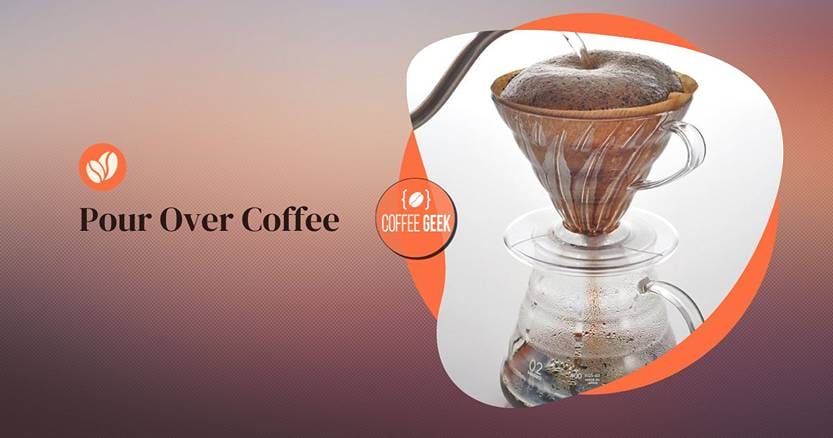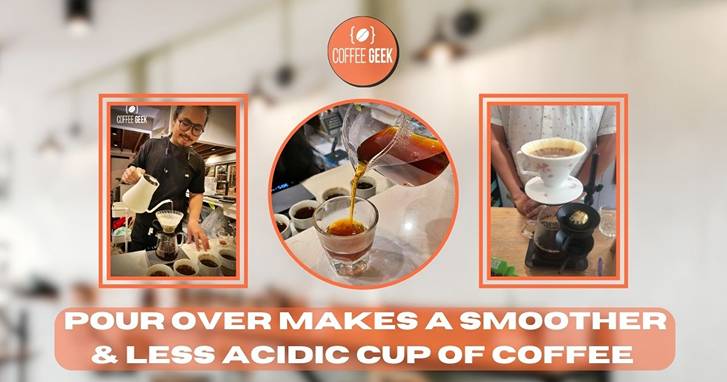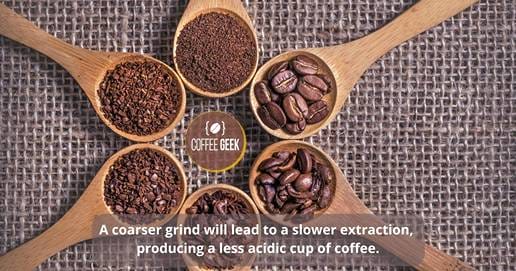Acidity is a common topic in the world of coffee, often being discussed in relation to brewing methods and how it can affect a drinker’s experience.
It’s no secret that some people prefer coffee with less acidity, which leads to the question: is pour over coffee less acidic?
The answer is yes; pour-over coffee is indeed considered less acidic compared to other brewing such as drip or French press.
The pour-over method involves using a paper filter that influences the coffee’s extraction, flavor, and ultimately, its acidity.

This paper filter helps to trap sediment that may contribute to higher acidity, leading to a smoother, less acidic cup of coffee.
This characteristic is appealing to those who want a more gentle coffee experience, particularly for those with sensitive stomachs.
Key Takeaways
- Pour over coffee is less acidic compared to other brewing like drip or French press.
- The use of a paper filter in the pour over method results in a smoother and less acidic coffee.
- Acidity in coffee can be influenced by factors like brewing methods, water composition, and individual taste preferences.
Understanding Acidity in Coffee
Coffee is often a go-to beverage for many people, but the acidity in coffee can sometimes be a concern.
It’s essential to understand what acidity in coffee means and how it affects the overall taste and sensation of the drink.

Acidity in coffee refers to the bright, tangy flavors often present in a cup of coffee. These flavors are the result of certain acids naturally found in the coffee beans.
The acidity in coffee is measured on the pH scale, which ranges from 0 (very acidic) to 14 (very basic). Coffee typically falls within the pH range of 4-5, making it a relatively acidic beverage.
There are several factors that can influence the acidity of coffee, including the type of bean, the roast level, and the brewing method.
For instance, arabica beans tend to be more acidic than robusta beans, while darker roasts generally have lower acidity levels.

One popular brewing method, pour-over coffee, is often believed to yield a less acidic cup.
The controlled brewing process of pour-over coffee allows for a slow and even extraction of flavors, leading to an extraction of acids in a more balanced manner.
This can result in a smoother and less acidic cup of coffee.
Some drinkers may prefer less coffee acidity due to personal preference or sensitivity to acidic foods and beverages.
If that’s the case, exploring different bean types, roast levels, and brew methods can help to find a coffee with a more palatable acidity level.

Keep in mind that while pour-over coffee may be less acidic, the difference might not be substantial enough for some sensitive individuals.
To summarize, understanding acidity in coffee involves considering bean type, roast level, and brewing method.
Pour-over coffee could potentially provide a smoother and less acidic option for those who prefer a milder cup.
Pour Over Coffee Basics
Pour over coffee is a popular brewing that allows for greater control over the extraction process. It typically results in a smoother and less acidic cup compared to other brewing methods like drip or French press.
When making pour over coffee, you’ll need a dripper and a paper filter. Some popular drippers include the Chemex and the V60.
These drippers enable precision and consistency during brewing, which contributes to the coffee’s balanced flavor and reduced acidity.

The process begins by placing the paper filter in the dripper, then adding coffee grounds. Next, hot water is slowly poured over the grounds in a circular motion, ensuring that the grounds are evenly saturated.
This controlled brewing method extracts the flavors and acids at a more consistent rate compared to other methods, which can result in a less acidic taste.
One reason pour over coffee may be less acidic is because the paper filter traps the sediment.
This allows the coffee to settle on top of the grounds, creating a cleaner cup with fewer particles that could contribute to acidity.

Overall, pour over coffee offers coffee enthusiasts an enjoyable and potentially less acidic cup of coffee, thanks to its controlled brewing process and the use of paper filters.
With a variety of drippers available, like the Chemex and V60, there are plenty of options for those looking to experiment with this brewing process.
Factors Affecting Acidity in Coffee
Coffee Beans and Roast
The type of coffee beans and the roast level can significantly impact the acidity levels in coffee.
Arabica beans are known for their delicate flavors and tend to have higher acidity compared to the Robusta beans, which have a more robust flavor and lower acidity.
As for the roast levels, light roasts preserve more acidity than medium and dark roasts. Dark roasts typically have reduced acidity levels, offering a smoother taste for those with sensitive stomachs.
Grind Size
The size of the coffee grounds also plays a role in determining the acidity in coffee. A finer grind results in a larger surface area, allowing for a higher extraction rate of the acidic compounds.

On the other hand, a coarser grind will lead to a slower extraction, producing a less acidic cup of coffee. Adjusting grind size can be an effective way to control the acidity to suit individual preferences.
Water and Its Temperature
Water quality and temperature are essential factors in determining the acidity of coffee. Hard water, with its high mineral content, can affect the extraction process, leading to higher acidity levels.
Conversely, soft water with low mineral content can result in a lower acidity coffee. Using filtered water can help balance the mineral content and provide a better cup of coffee.
The water temperature also plays a role in coffee’s acidity.
Higher water temperatures can extract more acids in a shorter time, while lower temperatures will require more time to extract the acids, ultimately affecting the final acidity levels.
Pour over coffee, for example, often uses slightly lower water temperatures compared to other methods, contributing to its reputation as a less acidic brewing technique.
| Brewing Method | Acidity Level | Description |
|---|---|---|
| Pour-Over | Medium | Pour-over coffee typically has a moderate level of acidity. It allows for more control over variables such as water temperature and pouring technique, which can influence acidity. |
| Espresso | High | Espresso tends to have a high acidity level due to the quick extraction process, which can bring out the bright and acidic notes in the coffee beans. However, this can vary depending on the coffee bean and roast. |
| French Press | Low | French press coffee generally has a lower acidity level because it involves a longer steeping time, resulting in a smoother and less acidic cup. |
| Cold Brew | Low | Cold brew is known for its low acidity, as the cold steeping process minimizes the extraction of acidic compounds, resulting in a mellow and less acidic flavor. |
| Aeropress | Varies | Aeropress coffee can vary in acidity depending on the brewing method used. Short steeping times can yield a more acidic cup, while longer steeping times produce a milder flavor. |
Pour Over Coffee Brewing Process
The pour over brewing coffee process involves various steps that contribute to the unique taste and acidity of the coffee.
In this section, we will explore the factors affecting the acidity of pour over coffee, such as choosing the right filter, extraction time, and contact time.
Choosing the Right Filter
The type of filter used in pour over coffee brewing can have a significant impact on the final product for coffee drinkers. There are generally two types of filters: paper filters and metal filters.

Paper filters can trap more sediment and oils, resulting in a cleaner and less acidic cup of coffee.
On the other hand, metal filters allow for more oils and sediments to pass through, which can lead to a slightly more acidic and robust flavor.
Extraction Time
Extraction time plays a crucial role in determining the acidity of pour over coffee. A slower extraction allows for a more balanced extraction of the coffee’s acids, resulting in a smoother and less acidic taste.
To achieve an optimal extraction, it is essential to pour the water slowly and evenly over the coffee grounds.
Contact Time
Contact time refers to the duration the water is in contact with the coffee grounds during brewing. The pour over methods usually has a shorter contact time compared to other brewing, such as a French press.
This shorter contact time can contribute to a less acidic cup of coffee, as it minimizes the extraction of the more acidic compounds found in coffee beans.
In summary, the factors affecting the acidity of pour over coffee include the type of filter used, extraction time, and contact time.
Adjusting these factors can help one achieve a smoother and less acidic cup of coffee according to their preferences.
Comparing Pour Over to Other Brewing Methods
French Press
The French press method involves steeping coffee grounds in hot water, and then pressing them to separate the liquid from the grounds.
This brewing technique often results in more body and sediment in the final cup compared to pour over.
However, the longer brewing process can lead to more acidic coffee since it allows for extra extraction, which could be unfavorable for those with sensitive stomachs.
Drip Coffee
Drip coffee makers work by allowing hot water to flow through coffee grounds in a filter, with the brewed coffee dripping into a carafe below.
This method tends to produce a more acidic brew compared to pour over coffee, as the brewing process is longer and there is a higher chance of over-extraction.
In addition, the flavors and aroma of drip coffee can be less delicate than those of pour over coffee, since the water comes into contact with the grounds for a longer period of time.

Espresso
Espresso is a strong coffee made by forcing hot water through finely ground coffee beans under high pressure.
Despite its intensity, espresso can be less acidic than another brewing process, as the rapid extraction process limits the amount of time the water has to interact with the beans.
However, flavor and aroma profiles can vary heavily depending on variables like bean quality, grind size, and temperature, making it difficult to generalize about espresso’s overall acidity compared to pour over coffee.
In conclusion, pour over coffee is often considered less acidic than other brewing processes like French press and drip coffee.
It’s important to remember that factors such as bean quality, grind size, and brewing time will still play a role in determining the final acidity level.
Experimenting with different methods can help coffee lovers find the balance that works best for their taste preferences and stomach sensitivity.
Tips for Reducing Acidity in Coffee – Is Pour Over Coffee Less Acidic?
Pour over coffee is indeed considered to be less acidic than other brewing processes such as drip or French press coffee.
However, there are several other factors and techniques you can employ to further decrease the acidity of your coffee.
Firstly, consider using coffee beans grown at a higher elevation, as they tend to have lower acidity. The mineral content of the soil, particularly calcium, plays a significant role in the acidity of the coffee.
The less acidic the soil, the less acidity will be transferred into the final product.
When brewing your coffee, pay attention to the brewing time. A shorter brewing time can result in lower acidity levels.
Experiment with different brewing times to find the perfect balance between taste and acidity for your preference.
Incorporating specialty coffee into your brewing process may also help reduce acidity.
Specialty coffee is typically sourced from higher elevations and grown under more controlled conditions, leading to a smoother, less acidic cup.
Another important factor to consider is the water you’re using to brew your coffee. Soft water, characterized by its low mineral content, can help lower the perception of acidity in your cup of coffee.
Lastly, lifestyle changes can also impact your sensitivity to acidity in coffee.
Engaging in regular aerobic and anaerobic exercises may help improve your digestion and reduce the effects of Coffee acidity on your body.
By considering these factors and making adjustments to your brew coffee process, you can enjoy a delicious cup with less acidity while still maintaining a rich, flavorful coffee taste.
Catering to Individual Preferences
When it comes to coffee, taste often plays a significant role in influencing individual preferences. While some prefer a strong and bold flavor, others might lean towards a smooth and mellow taste.
Pour over coffee can cater to a wide range of preferences, thanks to its versatile brewing.
With the ability to control the water temperature and flow through the coffee grounds, coffee lovers can experiment with different pouring techniques to achieve their preferred flavor profile.
For those with sensitive stomachs, the reduced acidity of pour over coffee can be a game changer.
Since the pour over method uses a paper filter, it helps to extract coffee at a more balanced rate, resulting in a smoother and less acidic cup of coffee.
This feature is particularly beneficial for individuals who experience discomfort from drinking more coffee acidity brewing options, such as drip or French press coffee.
One of the key elements that make pourover coffee a popular choice for catering to individual tastes is the ability to use a variety of beans originating from different regions.
Each bean type brings its own unique characteristics and acidity levels, offering a plethora of options for coffee enthusiasts to explore and discover their personal favorite cup.
In conclusion, the pour over coffee brewing type is not only versatile in terms of taste but also more gentle on delicate stomachs due to its lower acidity levels.
With the ability to experiment and fine-tune the brewing process, lovers of coffee can ensure their coffee caters to their personal preferences, making every cup a truly satisfying experience.
Frequently Asked Questions
Does pour over brewing affect acidity?
Yes, the pour over brewing method can affect acidity. The slow and even extraction of flavor allows acids in the coffee to be extracted at a more balanced rate, which can result in a smoother and less acidic cup of coffee.
However, the acidity levels can still vary depending on factors such as the type of coffee beans used and the brewing.
How does pour over compare to other brewing methods?
Compared to other brewing methods, pour over coffee may contain less acidity. For example, dark roast coffees and espresso beans tend to be less acidic due to the roasting process
Additionally, because of the controlled brewing in pour over, a more balanced extraction can be achieved.
What makes pour over coffee healthier?
Pour over coffee can be considered healthier for those with sensitive stomachs coffee drinkers as it generally contains less acid than other brewing methods.
Less acidity may help reduce symptoms associated with acid reflux or other stomach issues.
However, it is important to remember that individual tolerances differ, and what may work for one person may not work for another.
Are there drawbacks to pour over coffee?
One potential drawback of pour over coffee is that it may take more time and effort to prepare compared to other brewing methods.
The process requires more attention to detail in terms of water temperature, brewing time, and technique.
For some, this might seem less convenient compared to other methods like coffee drip or espresso machines. Does pour over coffee taste less acidic?
The taste of pour over coffee can be smoother and less acidic, depending on factors such as bean type, brewing, and individual preferences.
t is essential to experiment with different variables to achieve the desired taste and acidity level for personal preference.
How does pH level vary in pour over coffee?
The pH level of brewing pour over coffee may vary depending on various factors, including the type of coffee beans used, the water’s mineral content, and brewing techniques.
However, pour over coffee generally has a more balanced coffee extraction, which can contribute to a smoother and less acidic flavor.
Again, individual taste preferences may determine whether pour over coffee’s pH level enhances or detracts from one’s enjoyment.

